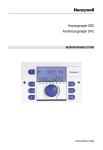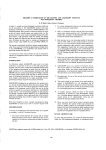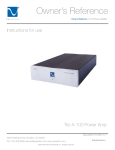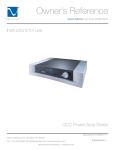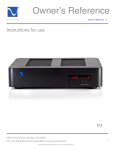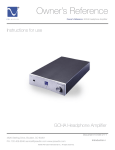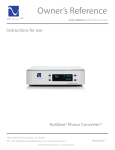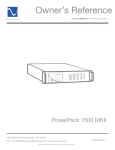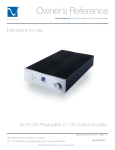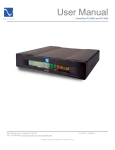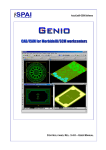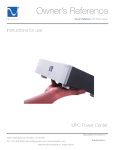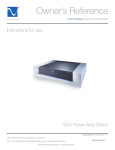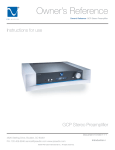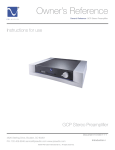Download GCPH Phono Preamplifier.indd
Transcript
® Owner’s Reference Owner’s Reference GCPH Phono Preamplifier Instructions for use GCPH Phono Preamplifier Document 15-044-11-1 4826 Sterling Drive, Boulder, CO 80301 PH: 720.406.8946 [email protected] www.psaudio.com ©2005 PS Audio International Inc. All rights reserved. Introduction i ® Introduction Owner’s Reference GCPH Phono Preamplifier Important Safety Instructions Read these instructions Heed all warnings Follow all instructions WARNING. TO REDUCE THE RISK OF FIRE OR ELECTRICAL SHOCK, DO NOT EXPOSE THIS APPARATUS TO RAIN OR MOISTURE. Clean only with a dry cloth. Do not place flammable material on top of or beneath the component. All PS Audio components require adequate ventilation at all times during operation. Rack mounting is acceptable where appropriate. Do not remove or bypass the ground pin on the end of the AC cord. This may cause RFI (radio frequency interference) to be induced into your playback setup and is potentially unsafe. All PS products ship with a grounding type plug. If the provided plug does not fit into your outlet, consult an electrician for replacement of the obsolete outlet. Protect the power cord from being walked on or pinched particularly at plugs, convenience receptacles, and the point where they exit from the apparatus. Unplug this apparatus during lightning storms or when unused for long periods of time. When making connections to this or any other component, make sure all components are off. Turn off all systems’ power before connecting the PS Audio component to any other component. Make sure all cable terminations are of the highest quality. There are no fuses inside this product. THERE ARE NO USER-SERVICEABLE PARTS INSIDE ANY PS AUDIO PRODUCT. REFER ALL SERVICING TO QUALIFIED SERVICE PERSONNEL Please contact your authorized dealer, distributor, or PS Audio if you have any questions not addressed in this reference manual. This product is manufactured in the United States of America. PS Audio® is a registered trademark of PS Audio International Inc., and is restricted for use by PS Audio International, Inc., its subsidiaries, and authorized agents. 4826 Sterling Drive, Boulder, CO 80301 PH: 720.406.8946 [email protected] www.psaudio.com ©2005 PS Audio International Inc. All rights reserved. Introduction ii ® Table Of Contents Owner’s Reference GCPH Phono Preamplifier Introduction IV Getting Started 1 Quick Start Guide 2-3 Questions and Answers 4-5 Troubleshooting 6-7 Warranty 8-9 Service 10 - 11 4826 Sterling Drive, Boulder, CO 80301 PH: 720.406.8946 [email protected] www.psaudio.com ©2005 PS Audio International Inc. All rights reserved. Table Of Contens iii ® Introduction Owner’s Reference GCPH Phono Preamplifier Thank you for your purchase of the PS Audio GCPH Phono Preamplifier. What will it do? The GCPH is a high-end standalone phono preamplifier, designed for the highest quality phono reproduction possible. It is based on PS Audio’s unique Gain Cell Technology and over 30 years of designing state-of-the-art phono stages. PS Audio built its first phono stage in 1973 and has been responsible for some of the most loved vinyl amplification electronics the Audio world has ever known. Passive RIAA Curve The GCPH is built around the same design philosophy all PS phono preamplifiers have enjoyed over the last 30 years: a passive RIAA curve. The RIAA curve is a specification for the correct playback of vinyl records, established by the Recording Industry Association of America (RIAA). The purpose of the equalization curve is to permit greater playback times, improve sound quality, and to limit the physical extremes that would otherwise arise from recording analog records without such equalization. History of the curve The RIAA curve has operated as a de facto global industry standard for the recording and playback of vinyl records since 1954. Prior to that time - mainly between 1940 and 1954 - each record company applied its own equalization; there were over 100 combinations of turnover and rolloff frequencies in use, the main ones being AES, LP, NAB and FFRR. The RIAA standardized the EQ curve for records and hence the majority of vinyl LP’s are recorded to this standard. Before 1940, most records were cut flat. This included broadcast recordings and motion picture recordings before sound-on-film. If you play a pre-WWII 78rpm record through a modern preamp, you will effectively be playing it with a scratch filter whose cutoff begins at 2200Hz, giving lack of high frequencies and muffled voices. RIAA equalization is a form of pre-emphasis on recording, and de-emphasis on playback. A record is cut with the low frequencies reduced and the high frequencies boosted, and on playback the opposite occurs. The result is a flat frequency response, but with noise such as hiss and clicks arising from the vinyl surface attenuated. The other main benefit of the system is that low frequencies, which would otherwise cause the record cutter to make large excursions when cutting a groove, are reduced so grooves are smaller and more can be fitted in a given surface area, yielding longer playback times (hence the term “LP” or Long Play records). RIAA equalization is not a simple low-pass filter. It carefully defines roll-off points in three places, 2122 Hz, 500 Hz and 50 Hz. There are multiple means of achieving this curve in a phono preamplifier, but the two main implementations are active and passive. Active means the RIAA curve is in the feedback loop of the preamplifier and passive means it is outside any feedback loop. PS Audio has always believed the best performance will be achieved when the curve is outside the feedback loop of the internal amplifier because the amplifiers’ performance will change with frequency. This is because at high frequencies the negative feedback of the phono preamplifier will be very high and at low frequencies, relatively low. Our design philosophy of preamplification has always revolved around the notion of keeping negative feedback low and uniform at all frequencies. Thus, a passive RIAA curve is “just what the doctor ordered”. 4826 Sterling Drive, Boulder, CO 80301 PH: 720.406.8946 [email protected] www.psaudio.com ©2005 PS Audio International Inc. All rights reserved. Introduction iv ® Introduction Owner’s Reference GCPH Phono Preamplifier Accuracy is critical Whatever method is employed, it is absolutely critical the curve be as exact as possible. Deviations of more than a tenth of a dB are unacceptable. The GCPH is flat to the RIAA standard by less than 0.1dB. A unique feature of the GCPH is the multiple gain setting adjustment methods. The coarse gain settings are available on the rear of the unit, the fine gain setting available via a volume control like knob on the front panel. The front panel gain adjustment also allows the GCPH to be used as a standalone phono preamplifier, feeding the purest phono signal possible directly into your power amplifier. Enjoy! You should expect unrivaled sonic qualities, with low noise, high performance audio being delivered to your system through this unique and ground breaking phono preamplifier. Enjoy! 4826 Sterling Drive, Boulder, CO 80301 PH: 720.406.8946 [email protected] www.psaudio.com ©2005 PS Audio International Inc. All rights reserved. Introduction v ® Getting Started Owner’s Reference GCPH Phono Preamplifier Location Once your new GCPH is unpacked, you’ll need to find a convenient place to set it. Keep the GCPH away from magnetic fields such as those produced by transformers, power amplifiers, etc. This is a very high gain preamplifiers and is sensitive to radiated noise. There are several ways to mount the GCPH: on a shelf next to the preamplifier, or on a dedicated turntable stand. It is important to have the GCPH located as close as possible to the turntable and to use as short a cable as possible from the turntable to the GCPH. This will help lower noise. Isolation The GCPH can benefit from aftermarket isolation devices such as cones, spikes and Sorbothane pads. Power Cables Once you have chosen the location for the GCPH you can use the supplied AC power cord to connect it to the AC wall receptacle to get started, or you can use an aftermarket power cord and receptacle. We strongly recommend the use of a PS Audio xStream Power™ AC cable and a PS Power Port™ AC receptacle to feed the GCPH power. While the supplied power cable is adequate for the task of setup it is not going to provide the best performance. Choosing any xStream Power cable will make a significant performance improvement over the stock power cable. An xStream Plus would be our recommendation. Use a Power Plant It is further recommended that you power the GCPH with a PS Audio Power Plant if possible, or a UPC-200 or Ultimate Outlet if not. Power conditioning with the appropriate equipment will further the benefits of the GCPH phono preamplifier. Audio interconnects Connections from the turntable should be through high quality audio interconnects with proper shielding. Using inexpensive, off-the-shelf audio interconnects to feed the GCPH or between the GCPH and the preamplifier or power amplifier should be avoided if you expect the full benefits of this high-end audio phono preamplifier to be available. We would recommend using audio interconnects less than 3 meters in length. PS designs and sells a line of reference quality audio interconnects that are highly recommended. Please see your PS dealer for details. 4826 Sterling Drive, Boulder, CO 80301 PH: 720.406.8946 [email protected] www.psaudio.com ©2005 PS Audio International Inc. All rights reserved. Getting Started 1 ® Quick Start Guide Owner’s Reference GCPH Phono Preamplifier Once you have decided on the location and chosen the appropriate power and audio cables, you are ready to install the GCPH into your system. Connect to an AC power source Plug the GCPH into the AC power source using the AC power cable you selected. It is advisable to use as short a power cable as possible to the GCPH. Once the GCPH has been connected to the power source, make sure that power source is energized and providing AC power to the GCPH. Avoid switched outlets If you are using an AC wall receptacle to power the GCPH, make sure the AC receptacle is not a switched outlet. Switched outlets are those outlets that can be turned on/off with the wall switch. It is advisable to leave the GCPH powered at all times. Make sure the GCPH is on Start with the front panel Gain Control in the clockwise “off” position. There will be a small “click” at the lowest setting of the gain control. This is the on/off switch. Once the unit is powered, turn the gain control clockwise and the blue LED on the front panel should be lit. Insert into the system Insert the GCPH into the system by first connecting the GCPH to the turntable. Turntables typically have a pair of RCA style connections that should be plugged directly into the GCPH inputs. Most turntables have a separate ground wire and this should be connected to the rear panel green binding post. If your turntable does not have a separate ground wire, it may be advisable to run a separate wire from a metal screw or grounded area of the turntable to this post. Turntables are very sensitive to hum and grounding the table, head shell or cartridge to the GCPH can help lower hum. Feed either a preamp or a power amp Next, choose what the GCPH will feed. You can feed the output of the GCPH into a high level input on your preamplifier or integrated amplifier or you can feed its output directly into a power amplifier, using the GCPH front panel gain adjustment as a volume control. Both balanced (XLR) and unbalanced (RCA) outputs are available and can be used either separately or together for a dual feed if you would like. The GCPH is a fully balanced designed from input to output. Do not plug into a phono input If you choose to place the output of the GCPH into your preamplifier, integrated amplifier or receiver, do not plug it into a phono input that was designed for turntables. A phono input on many preamplifiers 4826 Sterling Drive, Boulder, CO 80301 PH: 720.406.8946 [email protected] www.psaudio.com ©2005 PS Audio International Inc. All rights reserved. Quick Start Guide 2 ® Quick Start Guide Owner’s Reference GCPH Phono Preamplifier is a very high gain input with an RIAA curve built in and was designed for the turntable only. You can use any high level input for the GCPH, regardless of its nomenclature. Once the GCPH has been connected to both the turntable and the preamplifier or power amplifier, turn the system on. Make sure the front panel gain control is all the way down (counterclockwise) and turn it up only after setting the rear panel gain and input impedance selectors. Changing these selectors can send some pretty loud thumps through the system, so make sure either the preamplifier volume is down or the GCPH front panel gain control is down when adjusting them. Set the gain and impedance Depending on the type of cartridge you are using, moving coil or moving magnet, set the rear and front panel gain and impedance settings appropriately at this time. The gain selection of the GCPH is accomplished by adjusting both amplifier stages inside the GCPH to best advantage. The GCPH is built from two gain blocks with a passive RIAA curve between them. The rear panel fixed gain and impedance selectors control the input gain block and the front panel gain control adjusts the second output gain block (it is NOT an attenuator but rather a gain adjustment of the Gain Cell). By optimizing both the input and output gain blocks for best noise and sonics, you can customize your GCPH for the best performance. Adjusting a moving coil cartridge To set the gain and impedance for a moving coil cartridge, use the higher gain settings and the lower impedance settings. Moving coil cartridges typically have lower output than moving magnet cartridges. The best way to adjust the gain of a moving coil cartridge is to first choose the coarse setting of the input gain block from the rear panel gain selector. Choices are 48/54/60/66dB. We recommend starting with 54dB to 60dB and then using the front panel second gain block adjuster to tweak in the gain value. If you choose a rear panel coarse gain setting that requires the front panel gain control to be close to either extreme of its range, minimum or maximum, change the rear panel coarse selector up or down in gain to allow the front panel control to be somewhere in the middle or upper ¾ of its range for best performance for best sonics. Moving coil cartridges typically require lower impedance settings to properly damp the high frequencies of the moving coil. Most moving coil cartridge manufacturers recommend either the 10 Ohm or 100 Ohm settings and we would recommend the 100 Ohm setting as a good starting point if you are unfamiliar with the sound of your moving coil cartridge. Raising the impedance will reduce the coil damping and increase the high frequency output of the coil. Using a higher than recommended impedance for a moving coil Many vinyl lovers tend to ignore this basic low impedance tenant of a moving coil cartridge and prefer the more open top end achieved by raising the impedance to the 1k or even the 47K position reserved for moving magnet cartridges. This practice is perfectly acceptable with the GCPH. However, many moving coil cartridges will sound overly bright at this higher impedance setting and so require either a lower impedance setting or careful adjustment of the VTA (vertical tracking angle) of the turntable to reduce the brightness. Typically a negative rake (where the rear pivot point of the arm is lower than the head shell where the cartridge is mounted) on the VTA will produce a less bright sound. Adjusting a moving magnet cartridge To set the gain and impedance of a moving magnet cartridge, use the lowest gain setting and the highest impedance. Moving magnet cartridges should be set to 48dB on the rear panel gain selector and should only be used at the 47K impedance setting. Using a lower impedance setting for a moving 4826 Sterling Drive, Boulder, CO 80301 PH: 720.406.8946 [email protected] www.psaudio.com ©2005 PS Audio International Inc. All rights reserved. Quick Start Guide 3 ® Questions And Answers Owner’s Reference GCPH Phono Preamplifier Should the unit be on all the time? The GCPH is best left powered on at all times. The power consumed is negligible and keeping it powered on will make sure the internal AC capacitors stay charged and the amplifier and Gain Cells sound their best whenever you are ready to listen to music. Using the front panel gain control as an on/off control (turning it fully counterclockwise), is fine as this does not actually shut power off to the unit There is no harm in leaving the unit on at all times as the lifespan of the GCPH will be unaffected. Are there any internal fuses? There is a user replaceable internal fuse inside the GCPH. However, this fuse should not be replaced without first consulting the factory service center for advice. It would be unusual for this fuse to blow and may indicate something is wrong with the unit. What cartridges can I use? The GCPH should work with any cartridge made. Mono and phase buttons The front panel mono and phase buttons can be an important element in achieving the best sound. If you are playing a mono record and using a stereo cartridge on the turntable, it is recommended you place the GCPH in mono mode. This sums the left and right channels together in the same manner as a mono cartridge would and will provide much better sonic performance. The polarity or phase control The polarity or phase button will flip the phase of both the left and right channels (or the summed mono channel) 180 degrees. No standard has ever been established, or certainly never adhered to, in the recording of music with respect to absolute phase. While many speculate this is an unimportant factor in playback, we firmly believe the opposite. Try it yourself Try it for yourself. You can push the phase button on the GCPH front panel “on the fly” as the record is playing and listen for the differences. They should be apparent in terms of imaging and even how the top end of a recording will sound on a high resolution audio playback system. The polarity switch does not add or subtract any circuitry to accomplish its task and is completely passive. This is possible because the GCPH is a 100% balanced design, using both phases from input to output and it is therefore a simple matter to reverse the phase with no audio degradation. Placement is critical Placement of the GCPH can be critical. This is an extremely high gain preamplifier and although it is well shielded in it’s case, the unit is still sensitive to radiated noise. Make sure you do not place the GCPH on or near other equipment that may radiate hum from its internal transformer into the GCPH. Power amplifiers would be an obvious candidate to keep the GCPH as far away from as possible. 4826 Sterling Drive, Boulder, CO 80301 PH: 720.406.8946 [email protected] www.psaudio.com ©2005 PS Audio International Inc. All rights reserved. Questions and Answers 4 ® Questions And Answers Owner’s Reference GCPH Phono Preamplifier Isolation? Isolation through the use of spikes, cones or Sorbothane feet is recommended for the GCPH if space and budget allows. Isolation of any piece of high-end stereo and theater equipment is always recommended wherever practical. What voltages can I run GCHA on? The GCPH is specific to your country’s voltage. Do not use the GCPH on a voltage higher than it is rated for. For instance, do not take a 120 volt rated GCPH and attempt to use it in a 220 volt country. Failure to observe this cautionary note will void your warranty. If you need to operate the GCPH at a voltage other than the voltage it was designed for, contact your dealer, distributor or the factory for help. The GCPH will generate a bit of heat and may remain warm to the touch. This is normal. We do not recommend removing power to the GCPH. We recommend leaving the GCPH powered at all times. 4826 Sterling Drive, Boulder, CO 80301 PH: 720.406.8946 [email protected] www.psaudio.com ©2005 PS Audio International Inc. All rights reserved. Questions and Answers 5 ® Troubleshooting Owner’s Reference GCPH Phono Preamplifier The GCPH will not power up If the GCPH Phono Preamplifier does not power up it is likely the unit is not getting AC power or the front panel Gain Control is set to off. Turn it clockwise to engage the on/off switch. No AC in If you suspect the unit is not getting power, test the receptacle feeding the GCPH power to see if there is power. The easiest way to do this is by using a lamp that you have previously verified works. Regardless of the receptacle’s type, that of a wall receptacle, a power conditioner, Power Plant or AC source of any kind, plug the lamp into the receptacle and verify there is AC power. Check the line cord Another possibility is the line cord. Swap line cords and make sure the unit has power. Sometimes the line cord feeding the GCPH is not functioning properly or not seated properly in the unit’s IEC connector. Switched outlets If the GCPH loses power mysteriously, chances are pretty good that you have the GCPH connected to a switched receptacle on the wall or the back of a receiver or a power conditioner. Switched AC receptacles are those receptacles that are controlled by a wall mounted power switch and are typically intended to be used to power on/off a lamp in the room. Most times these receptacles are unmarked and inadvertent switching on or off of the power switch can cause a lot of headaches trying to track down the reason your new equipment does not power up. Most switched receptacles are on the top AC receptacle in a two gang box. Always use the lower receptacle on the wall port if you are unsure. Refer to the service section If you have determined the GCPH does power on, after performing the above tests, turn to the service section of this manual for details on receiving service. Strained or distorted sound If the sound is occasionally strained or distorted on loud peaks, it is likely you have selected too much gain for the input gain block. Choose a lower gain setting on the rear panel gain selector and use the front panel gain selector to return to the same gain you had. Then repeat the passage that formerly distorted to verify the distortion is gone. Because the GCPH has so many gain possibilities it is relatively easy to get it wrong. A good rule of thumb would be to always have the lowest gain setting in the rear that allows the front panel gain setting to be in the ½ or ¾ position. Keep in mind that the rear panel gain setting control the input gain block of the GCPH and the front panel gain setting adjusts the output gain block (after the passive RIAA curve) of the GCPH. Too much hiss If the noise or hiss level of the GCPH is excessive, try raising the gain of the input gain block via the rear panel gain selectors. Do this incrementally, striving to keep the lowest gain setting possible without overloading or distorting the input gain stage. The self noise of the input gain block is dramatically reduced by the passive RIAA curve that feeds the output gain block of the GCPH. By adjusting the 4826 Sterling Drive, Boulder, CO 80301 PH: 720.406.8946 [email protected] www.psaudio.com ©2005 PS Audio International Inc. All rights reserved. Troubleshooting 6 ® Troubleshooting Owner’s Reference GCPH Phono Preamplifier first gain block to the appropriate gain setting you can keep the self noise (hiss) at a minimum. A good rule of thumb would be to always have the lowest gain setting in the rear that allows the best combination of noise and undistorted performance while permitting the front panel gain setting to be in the ½ or ¾ position. Keep in mind that the rear panel gain setting control the input gain block of the GCPH and the front panel gain setting adjusts the output gain block (after the passive RIAA curve) of the GCPH. Hum Hum is a common problem in turntable setups. This is because the cartridge on the turntable acts like an antenna connected to a very high gain amplifier (the GCPH). To minimize hum, make sure the turntable is properly grounded and properly shielded interconnects are used between the turntable and GCPH. Typically, turntables have a separate ground wire to be connected to the green binding post of the GCPH. If you are experiencing a higher level of hum than expected, try the system with and without the ground wire attached. It may be necessary to “cheat” the third wire AC ground of the GCPH with a 3 prong to 2 prong AC adapter in extreme circumstances. This method is not as safe as leaving the third wire AC ground connected so we do not recommend its use. Shielded cables Use of shielded cables between the turntable and the GCPH are mandatory. Over the years we’ve seen all manner of cable constructions that make the system “sound better”. While we are firm advocates of better cables for the highest-end performance, we are not advocates on unshielded cables between the turntable and the phono preamplifier. This is just asking for trouble from hum, his, radio stations etc. We strongly recommended not using anything but the best shielding on the interconnects. Our Transcendent line of interconnects are perfect for this application and you will not find a better sounding cable. Ground the headshell Lastly, it may be necessary to ground the headshell to the arm and subsequently to the ground wire. Some turntable manufacturers neglect to ground the cartridge mounting headshell to the tonearm. This means the the cartridge body is not grounded and will lend itself to acting like an antenna for hum, hiss, noise and radio stations. If you suspect this is the case, contact your turntable manufacturer for assistance. 4826 Sterling Drive, Boulder, CO 80301 PH: 720.406.8946 [email protected] www.psaudio.com ©2005 PS Audio International Inc. All rights reserved. Troubleshooting 7 ® Warranty Owner’s Reference GCPH Phono Preamplifier TERMS AND CONDITIONS PS Audio warrants the product designated herein to be free of manufacturing defects in material and workmanship, subject to the following conditions, for a period of three (3) years from the date of purchase by the original purchaser or date of shipment to the authorized PS Audio dealer, whichever comes first. Conditions This Warranty is subject to the following conditions and limitations: the Warranty is void and inapplicable if the product has been used or handled other than in accordance with the instructions in the owner’s manual, abused, or misused, damaged by accident or neglect or in being transported, or the defect is due to the product being repaired or tampered with by anyone other than PS Audio or an authorized PS Audio repair center. a. The product must be packaged and returned to PS Audio or an authorized PS Audio repair center by the customer at his or her sole expense in the original packing material. PS Audio will pay return freight of its choice for original purchasers. b. Return Authorization Number (RA Number) is required before any product is returned to our factory for any reason. This number must be visible on the exterior of the shipping container for PS Audio to accept the return. Units shipped to us without a Return Authorization Number or without a visible RA Number on the exterior of the shipping container will be returned to the sender, freight collect. c. RETURNED PRODUCT MUST BE ACCOMPANIED BY A WRITTEN DESCRIPTION OF THE DEFECT. PS Audio reserves the right to modify the design of any product without obligation to purchasers of previously manufactured products and to change the prices or specifications of any product without notice or obligation to any person. Remedy In the event the product fails to meet this Warranty and the above conditions have been met, the purchaser’s sole remedy under this Limited Warranty shall be to return the product to PS Audio or an authorized PS Audio repair center where the defect will be repaired without charge for parts or labor. Transfer of Warranty This Warranty is for the benefit of the original purchaser of the covered product and may be transferred to a subsequent purchaser of the product. Extended warranty policies: 1. By submitting the registration card, via mail or internet, within 90 days of purchase, the warranty period will be extended to 5-years from the date of purchase. 4826 Sterling Drive, Boulder, CO 80301 PH: 720.406.8946 [email protected] www.psaudio.com ©2005 PS Audio International Inc. All rights reserved. Warranty 8 ® Warranty Owner’s Reference GCPH Phono Preamplifier 2. If outside of the 90-day window of purchase, a 2-year extended warranty can be purchased for any PS Audio product within the original 3-year warranty period for a fee of $50. 3. To qualify for the extended warranty the Product must be purchased through an authorized PS Audio dealer or distributor and you must present a written receipt. 4. All of the policies of the extended warranty are the same as the limited warranty Miscellaneous This warranty does not cover the cost of custom installation, customer instruction, setup adjustments or signal reception problems. This warranty does not cover cosmetic damage or any damage due to accident, misuse, abuse, negligence or modification of, or to any part of the Product, without initial express consent from PS Audio. This warranty does not cover damage due to improper operation or maintenance, connection to improper voltage supply, or attempted repair by anyone other than a facility authorized by PS Audio to service the Product. This warranty is invalid if the factory applied serial number has been altered or removed from the Product. To locate the servicer or dealer nearest you, or for service assistance or resolution of a service problem, or for product information or operation, call or email PS Audio. ANY IMPLIED WARRANTIES RELATING TO THE ABOVE PRODUCT SHALL BE LIMITED TO THE DURATION OF THIS WARRANTY. THE WARRANTY DOES NOT EXTEND TO ANY INCIDENTAL OR CONSEQUENTIAL COSTS OR DAMAGES TO THE PURCHASER. Some states do not allow limitations on how long an implied warranty lasts or an exclusion or limitation of incidental or consequential damages, so the above limitations or exclusions may not apply to you. This Warranty gives you specific legal rights, and you may also have other rights that vary from state to state. Inquiries regarding the above Limited Warranty may be sent to the following address: PS Audio International, Inc., 4826 Sterling Drive, Boulder, Colorado 80301 ATTN: Customer Service; Email: [email protected]; Voice 720-406-8946; FAX: 720-406-8967. Outside the US PS Audio has authorized distribution in many countries of the world. In each country, the authorized importing retailer or distributor has accepted the responsibility for warranty of products sold by that retailer or distributor. Warranty service should normally be obtained from the importing retailer or distributor from whom you purchased your product. In the unlikely event of service required beyond the capability of the importer, PS Audio will fulfill the conditions of the warranty. Such product must be returned at the owner’s expense to the PS Audio factory, together with a photocopy of the bill of sale for that product, a detailed description of the problem, and any information necessary for return shipment. 4826 Sterling Drive, Boulder, CO 80301 PH: 720.406.8946 [email protected] www.psaudio.com ©2005 PS Audio International Inc. All rights reserved. Warranty 9 ® Service Owner’s Reference GCPH Phono Preamplifier If you require service in North America In the unlikely event there is a problem with your PS Audio component, please contact your dealer, distributor, or the PS Audio corporate research center to discuss the problem before you return the component to our California manufacturing facilities for repair. Products shipped to either the factory or the corporate research facilities will be refused and returned freight collect if not accompanied by a PS Audio Service Department issued return authorization number (RA Number). Obtain an RA number Return authorization numbers must be prominently displayed on the outside of the box and an accompanying letter describing the problem and re-listing the RA number must be inside the box to qualify for service. If you are transferring your warranty, you must first contact PS Audio or your dealer or distributor for details. To contact the PS Audio Service Department: Contact information If you are in the United States or Canada TELEPHONE HOURS FAX E-MAIL WEBSITE 720-406-8946 Monday-Friday, 9:00 am to 5:00 pm MST 720-406-8967 [email protected] http://www.psaudio.com If you are in the United States or Canada use the following procedure: 1. Obtain a Return Authorization Number (R/A number) and shipping address from the PS Audio Service Department. 2. Insure and accept all liability for loss or damage to the product during shipment to the PS Audio factory and ensure all freight (shipping) charges are prepaid. The product may also be hand delivered to the California or Colorado facilities if arrangements with the Service Department have been made in advance. Proof of purchase will be required for warranty validation at the time of hand delivery. Use original packing Use the original packaging to ensure the safe transit of the product to the factory, dealer, or distributor. PS Audio may, at its discretion, return a product in new packaging and bill the owner for such packaging if the product received by PS Audio was boxed in nonstandard packaging or if the original packaging was so damaged to the point it was unusable. If PS Audio determines that new packaging is required, the owner will be notified before the product is returned. To purchase additional packaging, please contact your authorized PS Audio dealer, distributor, or the PS Audio Service Department for assistance. If you are outside If you are outside the United States or Canada and require service you must contact your country’s the US or Canada dealer or distributor for instructions. PS Audio warranties its products (see warranty section) worldwide. 4826 Sterling Drive, Boulder, CO 80301 PH: 720.406.8946 [email protected] www.psaudio.com ©2005 PS Audio International Inc. All rights reserved. Service 10 ® Service Owner’s Reference GCPH Phono Preamplifier Service for PS Audio products outside the United States and Canada is handled through your country’s distributor or dealer. 1. Obtain a Return Authorization Number (R/A number) and shipping address from your dealer or distributor’s Service Department. 2. Insure and accept all liability for loss or damage to the product during shipment to the dealer or distributor’s Service Department and ensure all freight (shipping) charges are prepaid. If you have problems If you feel your country’s dealer or distributor is either unwilling or unable to service your PS Audio products, please contact our service department at [email protected] or at the above contact numbers to discuss the situation. Voltage changes Voltage changes to match your country’s voltage and frequency requirements to your PS Audio product are possible only through your dealer, your country’s authorized PS Audio distributor or the factory. Units purchased outside your country of residence will not be changed to the appropriate voltage unless prior arrangements have been made at the time of purchase. Please refer any questions to your dealer or distributor or by contacting the PS Audio service department. Your PS Audio product serial number is: Your serial number Please fill in the dealer or distributor’s information from where you originally purchased the unit. Your purchase information Date of purchase 4826 Sterling Drive, Boulder, CO 80301 PH: 720.406.8946 [email protected] www.psaudio.com ©2005 PS Audio International Inc. All rights reserved. Service 11


















